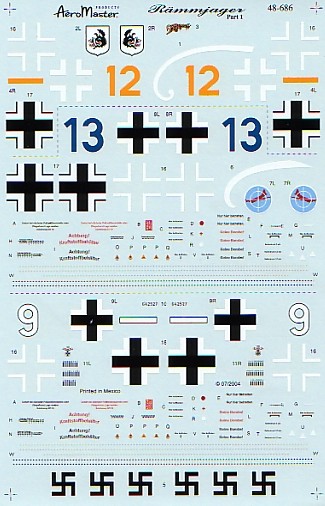The variety of colour schemes available to
the Fw190 is astounding and there are always fans of this aircraft
looking for new liveries to put them in.
Not surprisingly here is another
series of decal sheets to cater for these masses.
 There
are plenty of kits available to use but the family of DML and Tamiya
“Butcher Birds” are the recommended starting points. This is part 1 and
offers three options for the builder.
There
are plenty of kits available to use but the family of DML and Tamiya
“Butcher Birds” are the recommended starting points. This is part 1 and
offers three options for the builder.
- Fw190 A-8/R8, flown by
Unteroffizer Paul Lixfeld of 6. /JG300, November 1944.
Whilst being a firm favourite
amongst modellers, Lixfeld’s aircraft is also a controversial one. There
have been many interpretations and the following is the one provided by
AeroMaster.
RLM 74/75/76 is used as the
basic scheme with a darker colour sprayed around the cockpit area. It is
suggested that this could be RLM 66. The additional side armour is RLM
02 and the aircraft wears a yellow nose ring. Some sources believe the
yellow extended to the lower engine panel as well.
The colourful fuselage wears the
red JG300 RV band near the tail and the “Wilde Sau” emblem on the cowl.
This badge is depicted on a white shield but has been portrayed
elsewhere as yellow.
A further consideration for
modellers is whether or not this machine had its nose guns removed.
- Fw190 A-8, flown by Oberst.
Walter Dahl of Stab /JG300, Germany, June 1944.
This is one of Walter Dahl’s
more unusual aircraft. It carries the red JG300 Home Defence band on the
fuselage but also wears the IV. /JG3 badge on the cowling. Although it
is uncertain whether or not this appeared on the starboard side of the
aircraft, AeroMaster thoughtfully provide another “handed” version if
deemed necessary.
Finish is the standard RLM
74/75/76 with a yellow painted lower cowl. A white spiral is present on
the spinner and naturally this is included on the sheet.
Walter Dahl survived the war and
died in 1985 with 128 victories (some sources say 129) to his credit.
- FW190 A-7, Wk. Nr.642527
flown by Oberfeldwebel Adolf Glunz of 5. /JG26, Cambrai-Epinoy,
France late 1944
This more sedate scheme is
livened up by the pilot’s “scoreboard” on the yellow rudder. His
displayed tally at this stage being 54 aircraft. He went on to finish
the war with 71 (again sources differ with 72 also being mentioned)
including five in one day of which four were confirmed. Although never
shot down, he was once “wounded” in the lavatory he was visiting when
the RAF decided to bomb Abbeville in 1942.
Seen in the usual RLM 74/75/76,
“white 9” also featured the yellow over painting of the lower cowl, in
this case depicted as extending to the cowl ring as well. The white
horizontal Gruppe bar completes the fuselage markings with the
Werknummer seen in black at the top of the tail.
All markings are contained on a
single sheet that had no registration problems whatsoever. The printing
was sharp which meant that there was no difficulty reading any of the
provided stencil data. Of this we have enough for two complete aircraft,
which also includes the dashed wing walk areas. This latter item is
supplied in two colours, as are the drop tank markings, so the modeller
can choose their own preferred colouring option.
The instruction sheet contains
the typical camouflage pattern seen on the Fw190 and also gives a
placement guide for the stencil data.
Whether it is the pilot or the
aircraft, some interesting subjects have been captured for the modeller.
The high standard of printing seen previously is maintained and the
supplied stencil data is always appreciated.
This is a very colourful sheet
from AeroMaster and one that is sure to appeal to the Fw190 fan.
Recommended
Home | What's
New | Features
| Gallery |
Reviews | Reference
| Forum
| Search